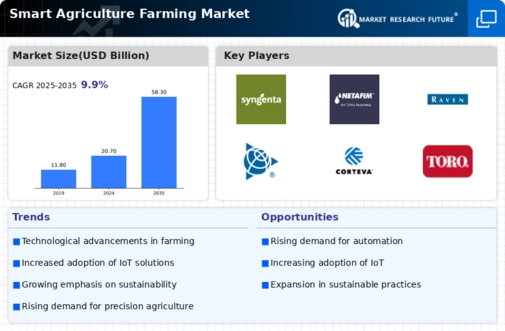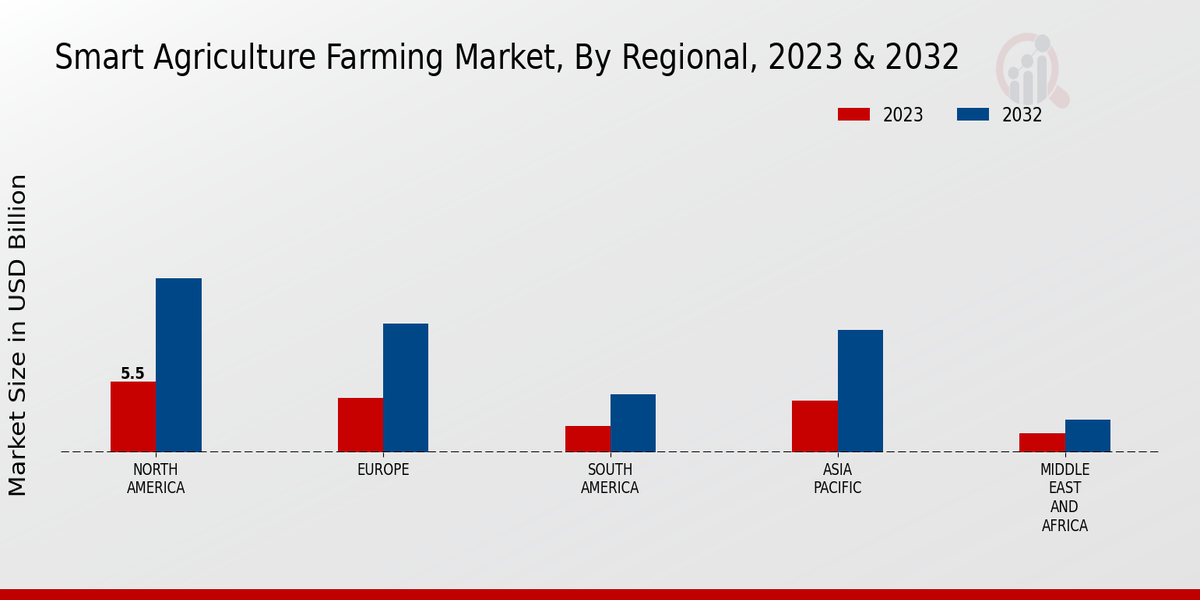Rising Global Population
The Global Smart Agriculture Farming Market Industry is significantly influenced by the rising global population, which is expected to reach approximately 9.7 billion by 2050. This demographic shift necessitates increased food production, thereby driving the demand for innovative agricultural practices. Smart agriculture technologies can enhance productivity and efficiency, addressing the challenges posed by limited arable land and water resources. As a result, the market is poised for substantial growth, with projections indicating a potential expansion to 58.3 USD Billion by 2035, reflecting the urgent need for sustainable farming solutions.
Market Growth Projections
The Global Smart Agriculture Farming Market Industry is projected to experience substantial growth over the coming years. With a market value of 20.7 USD Billion in 2024, it is expected to expand significantly, reaching 58.3 USD Billion by 2035. This growth trajectory reflects a compound annual growth rate (CAGR) of 9.85% from 2025 to 2035, driven by various factors including technological advancements, rising population, and increasing consumer demand for sustainable practices. The market's expansion indicates a robust shift towards innovative agricultural solutions that enhance productivity and sustainability.
Technological Advancements
The Global Smart Agriculture Farming Market Industry is currently experiencing a surge in technological advancements, which are transforming traditional farming practices. Innovations such as IoT devices, drones, and AI-driven analytics are enabling farmers to monitor crop health, optimize resource usage, and enhance yield. For instance, precision agriculture techniques allow for targeted application of fertilizers and pesticides, reducing waste and environmental impact. As these technologies become more accessible, the market is projected to reach 20.7 USD Billion in 2024, indicating a robust growth trajectory driven by the adoption of smart farming solutions.
Government Initiatives and Support
Government initiatives play a crucial role in the Global Smart Agriculture Farming Market Industry, as many countries are implementing policies to promote sustainable agricultural practices. These initiatives often include financial incentives, grants, and subsidies aimed at encouraging farmers to adopt smart technologies. For example, various governments are investing in research and development to enhance agricultural productivity through innovation. Such support not only fosters the growth of the smart agriculture sector but also aligns with global sustainability goals, further driving market expansion. The anticipated CAGR of 9.85% from 2025 to 2035 underscores the positive impact of these initiatives.
Climate Change and Environmental Concerns
The Global Smart Agriculture Farming Market Industry is increasingly shaped by climate change and environmental concerns, which are prompting a shift towards more sustainable farming practices. Farmers are facing challenges such as unpredictable weather patterns and resource scarcity, necessitating the adoption of technologies that enhance resilience. Smart agriculture solutions, including climate-smart practices and data-driven decision-making, can mitigate these challenges by optimizing resource use and reducing carbon footprints. As awareness of environmental issues grows, the market is likely to see accelerated adoption of smart technologies, contributing to its projected growth.
Consumer Demand for Sustainable Practices
The Global Smart Agriculture Farming Market Industry is also driven by the rising consumer demand for sustainably produced food. As consumers become more conscious of the environmental and social impacts of their food choices, there is a growing preference for products that are cultivated using sustainable practices. Smart agriculture technologies facilitate transparency and traceability in food production, enabling farmers to meet these consumer expectations. This shift towards sustainability not only enhances market opportunities but also aligns with broader trends in food consumption, further propelling the growth of the smart agriculture sector.


















